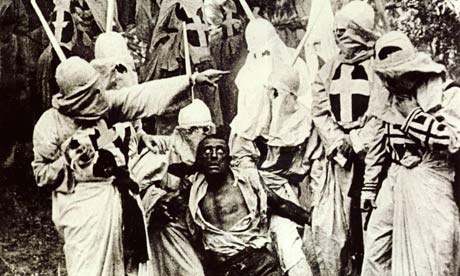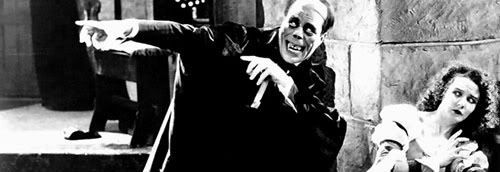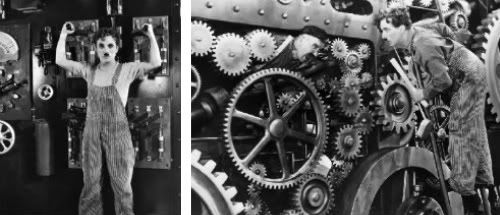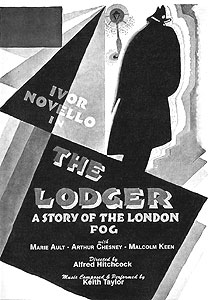I was just wondering if anyone here was into silent films. I've only seen a couple of silent films ("nosferatu" and the "cabinet of caligari"). but man I'm hooked! I have fritz lang's "destiny" to watch and A LOT of others on my list to get.
Silent Films
I've still only seen one so far, and that was The General, which was pretty good. I have City Lights waiting for me to watch sometime in the next few days.
X
User Lists
I watched Sunrise: A Song of two Humans last night, it was decent. It didn't really blow my skirt up, but it was interesting.
I've been trying to get to The General and several other tramp flicks. I just have a ton of movies to watch...
I've been trying to get to The General and several other tramp flicks. I just have a ton of movies to watch...
__________________
We are both the source of the problem and the solution, yet we do not see ourselves in this light...
We are both the source of the problem and the solution, yet we do not see ourselves in this light...
X
Favorite Movies
I'm quite fond of The General myself. I've seen two other Buster Keaton movies, Our Hospitality and Sherlock Jr. They were both worth a look see. I enjoyed them and have other Keatons in my queue.
__________________
Do not meddle in the affairs of Dragons.....for you are crunchy and good with ketchup.
Do not meddle in the affairs of Dragons.....for you are crunchy and good with ketchup.
X
Favorite Movies
X
User Lists
YES. You seem interested in the Germanic side, so be sure to watch Metropolis. I love silent films. They are the most purely cinematic films there are. I made a link at another thread... Here it is.
P.S. I think that Powdered Water needs to wear less-weighty skirts.
P.S. I think that Powdered Water needs to wear less-weighty skirts.

__________________
It's what you learn after you know it all that counts. - John Wooden
My IMDb page
It's what you learn after you know it all that counts. - John Wooden
My IMDb page
X
Favorite Movies
X
User Lists
I hope to watch City Lights soon (I believe that's silent) and/or The Gold Rush. The probably being that my local rental store don't have them for availability.
__________________
A film is - or should be - more like music than like fiction. It should be a progression of moods and feelings. The theme, what's behind the emotion, the meaning, all that comes later.
Stanley Kubrick
X
Favorite Movies
X
User Lists
Yeah I like the german films. I'm gonna get "the golem" "faust" and "the street" next, though "city lights", "the general" and several d.w. griffith movies are also on my list. I've got a lot of movies I want to see, it's just finding the time.
I've still only seen one so far, and that was The General, which was pretty good. I have City Lights waiting for me to watch sometime in the next few days.
Another reason may be that even the best of silent films is a bit more difficult to watch compared to modern films; it's always going to feel odd to see a character mouth a few sentences and then find out what they said, while the text lingers on screen longer than you need it to. But with silent comedies, the comedy is such that it's almost all seen, and very little is said, so it moves at a pace that most of us are more used to, anyway, by having fewer title cards to bog things down.
X
Favorite Movies
X
User Lists
Gotta start with the 10-minute long, 14-scene The Great Train Robbery (1903), the first narrative Western film with a storyline, one of the earliest films to be shot out of chronological sequence, using revolutionary parallel cross-cutting (or parallel action) between two simultaneous events or scenes; it did not use fades or dissolves between scenes or shots; it effectively used rear projection in an early scene (the image of a train seen through a window), and two impressive panning shots. It had exterior scenes, chases on horseback, actors that moved toward (and away from) the camera, a camera pan with the escaping bandits, and a camera mounted on a moving train. It was the first 'true' western. More important, it was the first real motion picture smash hit, establishing the concept that film could be a commercially-viable medium.
For intense emotional drama, see Greed (1924) with Zazu Pitts back before her costarring with Gail Storm on TV.
Another great drama, Way Down East, which shows Lillian Gish struggling through a real blizzard and fleeing across real ice floes in a real river. When she falls on one chunk of ice and her hand and hair trail in the water, it’s really frosty. There's also a shot of the leading man rescuing her and jumping from ice floe to ice floe carrying her to safety before they both go over a waterfall. Exciting!
Douglas Fairbanks was famous for doing his own stunts and all of his films are extremely active. But my special favorite is Mark of Zorro: there’s an extended scene in that film where the bad guys are chasing Fairbanks all over the rancho, and the chase goes on for many minutes with him jumping in and out of windows, over and under fences, climbing walls, leaping off roofs, you name it. It is one of the most strenuous chase scenes ever filmed. Don’t know if it was actually shot in one long take, but there are extended periods of him just running, jumping, and swinging from ropes that it would have exhausted most athletes.
Battleship Potemkin (1925) is one of the greatest films ever made. Check out how many scenes have been repeated in other movies.
The Big Parade (1925) and Wings (1927) are two of the best war movies ever filmed. The aerial stunts in Wings are probably the best ever filmed, and it won the first Academy Award for best picture.
Lang’s futuristic Metropolis (1927) (Wasn’t M also shot first as a silent? I seem to remember seeing a silent version of it once.)
Any of Lon Chaney’s films are good, but don’t miss Tell It to the Marines, in which he played a Marine sergeant who would have kicked John Wayne’s butt on the Sands of Iwo Jima. It was his biggest box office success and so good that the Marine Corps. made him an honorary Marine. Everyone remembers Phantom, but probably his most far-out horror film is The Unknown (1927).
Several have mentioned The General (1927), a great film, but I think the stunts were both more spectacular and maybe even funnier in Steamboat Bill Jr. and The Cameraman (both in 1928).
Everything by Chaplin is good, but I’m especially fond of The Gold Rush (1925). Back in the 1960s, I was poor-boying through cottage in a cheap garage appointment, no car, no money, no girls. All I did was work and study. So one evening, I see the Student Union is having a free showing of The Gold Rush. Went to see it for the first time and laughed so hard that my ribs hurt for days after. Maybe I was just starved for entertainment, but it still makes me laugh when I see it.
Anything by Harold Lloyd—he was nearly as funny as Chaplin and did stunts almost as well as Buster Keaton.
For intense emotional drama, see Greed (1924) with Zazu Pitts back before her costarring with Gail Storm on TV.
Another great drama, Way Down East, which shows Lillian Gish struggling through a real blizzard and fleeing across real ice floes in a real river. When she falls on one chunk of ice and her hand and hair trail in the water, it’s really frosty. There's also a shot of the leading man rescuing her and jumping from ice floe to ice floe carrying her to safety before they both go over a waterfall. Exciting!
Douglas Fairbanks was famous for doing his own stunts and all of his films are extremely active. But my special favorite is Mark of Zorro: there’s an extended scene in that film where the bad guys are chasing Fairbanks all over the rancho, and the chase goes on for many minutes with him jumping in and out of windows, over and under fences, climbing walls, leaping off roofs, you name it. It is one of the most strenuous chase scenes ever filmed. Don’t know if it was actually shot in one long take, but there are extended periods of him just running, jumping, and swinging from ropes that it would have exhausted most athletes.
Battleship Potemkin (1925) is one of the greatest films ever made. Check out how many scenes have been repeated in other movies.
The Big Parade (1925) and Wings (1927) are two of the best war movies ever filmed. The aerial stunts in Wings are probably the best ever filmed, and it won the first Academy Award for best picture.
Lang’s futuristic Metropolis (1927) (Wasn’t M also shot first as a silent? I seem to remember seeing a silent version of it once.)
Any of Lon Chaney’s films are good, but don’t miss Tell It to the Marines, in which he played a Marine sergeant who would have kicked John Wayne’s butt on the Sands of Iwo Jima. It was his biggest box office success and so good that the Marine Corps. made him an honorary Marine. Everyone remembers Phantom, but probably his most far-out horror film is The Unknown (1927).
Several have mentioned The General (1927), a great film, but I think the stunts were both more spectacular and maybe even funnier in Steamboat Bill Jr. and The Cameraman (both in 1928).
Everything by Chaplin is good, but I’m especially fond of The Gold Rush (1925). Back in the 1960s, I was poor-boying through cottage in a cheap garage appointment, no car, no money, no girls. All I did was work and study. So one evening, I see the Student Union is having a free showing of The Gold Rush. Went to see it for the first time and laughed so hard that my ribs hurt for days after. Maybe I was just starved for entertainment, but it still makes me laugh when I see it.
Anything by Harold Lloyd—he was nearly as funny as Chaplin and did stunts almost as well as Buster Keaton.
X
Favorite Movies
X
User Lists
. . . may be that even the best of silent films is a bit more difficult to watch compared to modern films; it's always going to feel odd to see a character mouth a few sentences and then find out what they said, while the text lingers on screen longer than you need it to. But with silent comedies, the comedy is such that it's almost all seen, and very little is said, so it moves at a pace that most of us are more used to, anyway, by having fewer title cards to bog things down.
I do agree that physical comedy moves fast on the silent screen but then so do many of the adventure films with Fairbanks, Rin Tin Tin, and the Perils of Pauline series. Plus Rudolph Valentino's love scenes may not have moved very fast, but they still manage to hold the interest of many.
X
Favorite Movies
X
User Lists
One of my favorites is The Birth of a Nation. It's actually pretty disturbing in that it portrays the KKK as being the "good guys." I think one of the reasons I like it so much is because it's true. It shows you how twisted things were during the civil war.


X
Favorite Movies
X
User Lists
Yes, I know that Yoda dissed The Birth of a Nation earlier (and there's nothing wrong with that because it's obviously hateful on multiple levels and it's also very long), but it does tell a strong story and contains some awesome battle scenes which stand up to this very day. Even in the image you showed above, that's a white man in black-face-and-chest, but those were the times. I hope that people don't get mad at me for mentioning that Buster Keaton used several whites (both male and female) in blackface in his wonderful films. Why did he do it? I don't know. Do they make me think ill of him or his films? Call me a racist if you must, but no.
X
Favorite Movies
X
User Lists
One of my favorites is The Birth of a Nation. It's actually pretty disturbing in that it portrays the KKK as being the "good guys." I think one of the reasons I like it so much is because it's true. It shows you how twisted things were during the civil war.
X
Favorite Movies
X
User Lists
I've yet to see a single silent film , I really do prefer the blessing of audio 

__________________
X
Favorite Movies
X
User Lists
Yes, I know that Yoda dissed The Birth of a Nation earlier (and there's nothing wrong with that because it's obviously hateful on multiple levels and it's also very long), but it does tell a strong story and contains some awesome battle scenes which stand up to this very day. Even in the image you showed above, that's a white man in black-face-and-chest, but those were the times. I hope that people don't get mad at me for mentioning that Buster Keaton used several whites (both male and female) in blackface in his wonderful films. Why did he do it? I don't know. Do they make me think ill of him or his films? Call me a racist if you must, but no.
X
Favorite Movies
X
User Lists
Of the few I've seen, these are my top 5 fave:
5. Nosferatu -

4. Metropolis -

3. The Hunchback Of Notre Dame -

2. The Phantom Of The Opera -

1. Modern Times -

5. Nosferatu -

4. Metropolis -

3. The Hunchback Of Notre Dame -

2. The Phantom Of The Opera -

1. Modern Times -

__________________
Right now, all I'm wearing is a mustard-stained wife-beater T-shirt, no pants & a massive sombrero.
Right now, all I'm wearing is a mustard-stained wife-beater T-shirt, no pants & a massive sombrero.
Last edited by TheMightyCelestial; 05-27-11 at 10:58 PM.
X
Favorite Movies
X
User Lists
Some other silent films that I like that haven't been mentioned yet:

The Passion of Joan of Arc (1928, Dreyer)

Intolerance (1916, Griffith)

The Last Laugh (1924, Murnau)

The Passion of Joan of Arc (1928, Dreyer)

Intolerance (1916, Griffith)

The Last Laugh (1924, Murnau)
__________________
"Don't be so gloomy. After all it's not that awful. Like the fella says, in Italy for 30 years under the Borgias they had warfare, terror, murder, and bloodshed, but they produced Michelangelo, Leonardo da Vinci, and the Renaissance. In Switzerland they had brotherly love - they had 500 years of democracy and peace, and what did that produce? The cuckoo clock."
"Don't be so gloomy. After all it's not that awful. Like the fella says, in Italy for 30 years under the Borgias they had warfare, terror, murder, and bloodshed, but they produced Michelangelo, Leonardo da Vinci, and the Renaissance. In Switzerland they had brotherly love - they had 500 years of democracy and peace, and what did that produce? The cuckoo clock."
X
Favorite Movies
Mel brooks...Silent Movie...the one where the only word spoken during the whole movie is spoken by Marcel Marceau...genius!


